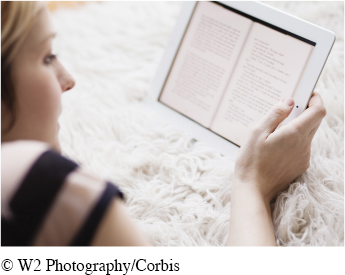Tech Tip: EMBRACE THE E-BOOK
TECH TIP



EMBRACE THE E-BOOK
In college we have textbooks, workbooks, and notebooks. Even though textbook publishers continue to make traditional books and materials available, students may be required (or prefer) to access some or all course material digitally. For students who are used to buying or renting printed books from the college bookstore, this can be confusing.
THE PROBLEM
You have heard about electronic books that are alternatives to traditional textbooks, but you aren’t sure what device to buy to read e-books. You also want to know the advantages and disadvantages that an e-book has when compared to a traditional book.
THE FIX
Explore different platforms that deliver e-book content, and discover how reading with a digital reader differs from (and can even be better than) reading traditional books.
HOW TO DO IT

Go to the library. Many libraries have tablets of different kinds. Ask a librarian to download a book in a variety of formats for you, so you can try different tablets out before choosing one to buy.
Try the different media available. E-books give you access to the pages of the text, as well as video, audio, and web content.
PROS OF E-BOOKS
- Digital reading devices are portable and can hold thousands of books.
- E-books save trees, can be bought without shipping costs, and have a low carbon footprint.
- E-readers let you buy books online from anywhere with Web access, and you can start reading within minutes.
- You can type, highlight, and copy and paste sections. You can also undo highlighting or revise notes.
- You can print out pages by hooking the device up to your printer or connecting to a printer on WiFi.
- You can access many e-books for free from the public library—even rare books.
- Some e-books come with bonus audio, video, or animation features.
- Many digital reading devices accept audio books and can read to you aloud.
- The backlit screen means that you can read with the light off, without disturbing anyone.
- You can adjust the size of the text.
- Some e-readers have a built-in dictionary. Others link to reference websites like Google or Wikipedia when a WiFi or 4G connection is available.
- E-books are searchable and even sharable.
CONS OF E-BOOKS
- Digital reading devices are expensive, breakable, and desirable to thieves.
- Looking at a screen can cause some eye fatigue.
- If you have only limited or temporary access to e-books for your college courses, your access will expire after the academic term.
GOOD TO KNOW
Some electronic readers are no-frills, basic models designed to replicate the experience of reading a paper book. Others offer browsers, video, music, and thousands of free and for-purchase apps. Most are Web-enabled, so you can use them for other purposes like listening to music or audio books, checking e-mail, creating presentations, and writing papers. This increased functionality might be distracting, but it can also make you more productive. Remember, though: if you have no Internet or WiFi connection, you may not be able to access your e-book.
EXTRA STYLE POINTS
Price your textbooks in both the print and digital formats. Factoring in the cost of the e-reader, which format is cheaper?